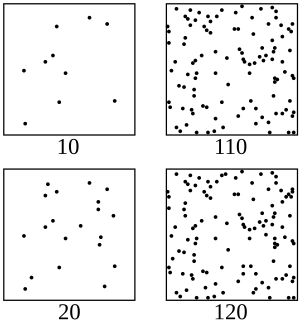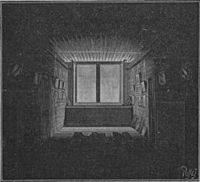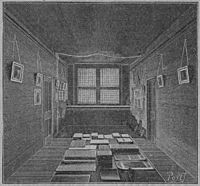Weber–Fechner law facts for kids
The Weber–Fechner laws are two important ideas in psychophysics. Psychophysics is the study of how our minds understand physical things. These laws help us understand how we notice changes around us. They explain the link between a real change in something physical (like light or sound) and how much we feel that change. This applies to all our senses: sight, hearing, taste, touch, and smell.
Weber's law says that to notice a change, the change itself must be a certain proportion of the original thing. For example, if you are holding a light weight, you will notice a small added weight. But if you are holding a very heavy weight, you need a much bigger added weight to notice it. Fechner's law builds on this. It suggests that our feeling of something (like how bright a light is) increases slowly, like a logarithm, not as quickly as the actual physical change.
Contents
Who Created These Laws?
Both Weber's law and Fechner's law were developed by Gustav Theodor Fechner (1801–1887). He first wrote about them in 1860 in his book Elements of Psychophysics. This book was the very first work in this field. Fechner even created the word "psychophysics" to describe this study. He believed it was a way to understand the connection between our bodies and our minds.
Weber's Law: Noticing Differences
Ernst Heinrich Weber (1795–1878) was one of the first scientists to study how people react to physical things in a measurable way. Fechner was Weber's student. He named his first law after Weber because Weber did the experiments that helped create the law.
Fechner explained Weber's law in a few ways. One way says: "It's easier to notice a small difference when the original things are small. The relative difference you can notice stays the same, no matter the size."
This means that how much you notice a change depends on the original amount of something. For example, if you have a quiet sound, a small increase will be very noticeable. But if the sound is already loud, you need a much bigger increase to notice it.
Weber's law also talks about the just-noticeable difference (JND). This is the smallest change in something that you can actually feel or notice. The JND is a certain proportion of the original thing. For example, if you can just tell the difference between 100 grams and 105 grams, the JND is 5 grams. If you then have 200 grams, you would need to add 10 grams (which is still 5% of 200) to just notice the difference. This percentage is called the "Weber fraction."
Weber's law works well for many things in the middle range of intensity. But it doesn't work as well for very weak or very strong things.
Fechner's Law: How We Feel Things
Fechner noticed that different people have different sensitivities. For example, some people are better at seeing small differences in light. He also saw that our senses react differently to changes. He used these ideas to create another version of Weber's law, which he called the "measurement formula."
Fechner's law says that how we feel a sensation (like brightness or loudness) is related to the logarithm of the actual physical intensity. This means that if you multiply the strength of a stimulus (like making a light 3 times brighter), our perception of it only adds up (like feeling it's 2 times brighter than before). If you make it 3 times brighter again, our feeling of brightness only adds another step. So, multiplying the real strength only adds to our feeling of it.
Just like Weber's law, Fechner's law doesn't work perfectly for very weak stimuli.
How We Perceive Things
Weber and Fechner studied how we notice differences in light and weight. Other senses also show some support for these laws, but it's not always perfect.
Feeling Weight
Weber found that the smallest difference you could notice between two weights was about a certain percentage of the weights. For example, if you can just tell the difference between 100 grams and 105 grams, the difference is 5 grams. If the weight is doubled to 200 grams, you would need to add 10 grams to notice a difference. This 5% is the "Weber fraction" for weight. This means you need to increase a weight by about 5% to reliably feel the increase.
Hearing Sounds
Weber's law is a good guess for how we hear loud sounds. But it doesn't work as well for very quiet sounds. For very loud sounds, our ability to tell differences actually gets better. This is known as the "near miss" of Weber's law in hearing.
Seeing Light
Our eyes see brightness in a way that is similar to a logarithm. This is why stellar magnitude (how bright stars appear) is measured on a logarithmic scale. The ancient Greek astronomer Hipparchus created this scale around 150 B.C. He ranked stars from 1 (brightest) to 6 (faintest). On this scale, an increase of 5 magnitudes means the star is 100 times fainter.
For vision, Weber's law means that the luminance contrast stays the same. Imagine an object against a background. To just see the object, it needs to be a little brighter or darker than the background. Weber's law says this difference, as a proportion of the background brightness, should be constant.
Human vision follows Weber's law well in normal daylight. But it starts to break down in dim light (like twilight) and doesn't apply at all in very low light. In very dark conditions, what we see is mostly our own brain's "noise" or "dark light."
See also
 In Spanish: Ley de Weber-Fechner para niños
In Spanish: Ley de Weber-Fechner para niños
- Human nature
- Level (logarithmic quantity)
- Nervous system
- Ricco's law
- Stevens's power law
- Sone
- Neural coding




